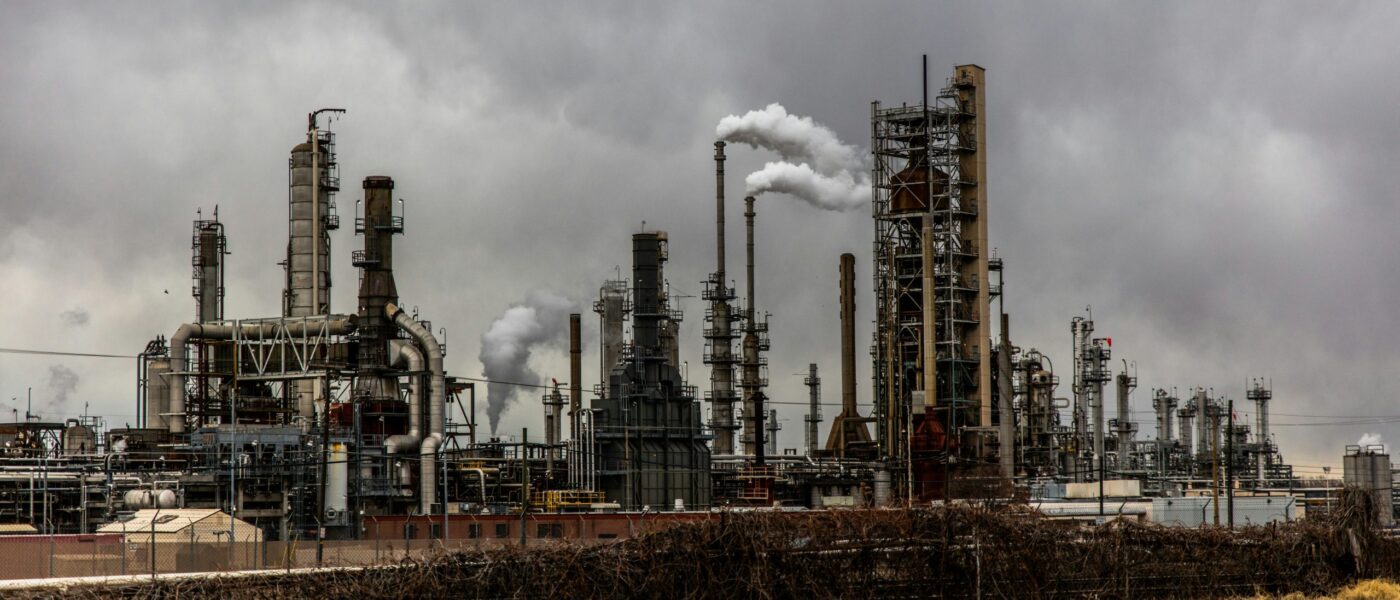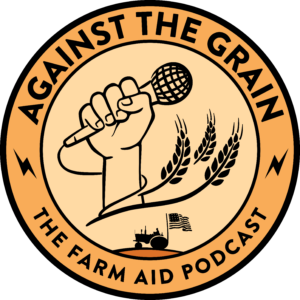Factory farm gas claims to be the industrial livestock industry’s solution for fighting climate change and reducing its greenhouse gas emissions. In reality, factory farm gas incentivizes and further entrenches unsustainable forms of farming, all while creating huge amounts of pollution and increasing greenhouse gas emissions.
What is factory farm gas?
Factory farm gas, often called “biogas,” is a byproduct of farm animal waste that is burned to produce energy. Factory farm gas is produced by siphoning off methane released from decomposing animal waste. In order to produce factory farm gas, large amounts of animal waste (which can include manure, animal corpses and excess milk) is placed in covered pits so that the waste decomposes anaerobically (without exposure to oxygen) using a technology called a methane or anaerobic digester. When organic matter decomposes this way, it produces a concentrated waste product called “digestate” as well as methane. This methane gas can be collected, transported and burned as fuel for energy.
Why is factory farm gas harmful?
It’s a common misconception that factory farm gas is a sustainable source of energy and a tool for reducing methane emissions. The biggest problem with factory farm gas is that it incentivizes the production of manure in order to produce methane, resulting in increased pollution and greenhouse gas emissions, all while posing as a clean and renewable energy source. Here are some reasons why factory farm gas is harmful:
- Factory farm gas and factory farms go hand-in-hand. The need for lots of manure to produce gas means methane digesters only make sense on factory farms, a type of industrial livestock production that is harmful to the environment and our food and farming system.
- Factory farm gas not only increases net greenhouse gas emissions, it also creates new pollution problems. Unlike unprocessed animal manure, digestate (the concentrated animal waste byproduct of methane digesters) has no agronomic value. While small livestock operations can apply manure as fertilizer on fields – an agricultural practice that when done sustainably, increases soil health and doesn’t create sources of pollution – factory farms wind up with huge amounts of waste that are harmful to human and environmental health and can’t be used as fertilizer.
- Factory farm gas is more toxic and corrosive than natural gas and it creates the same air pollutants as fossil fuels. Additionally, factory farm gas is transported using the same infrastructure as fracked gas, meaning that increasing investments in the biogas industry invests in and expands the fossil fuel industry.
- Methane digesters are prone to leaking and can overflow in the face of extreme weather events, as happened in North Carolina after Hurricane Florence. Animal waste and digestate contain dangerous bacteria as well as high levels of nutrients and heavy metals. When animal waste and digestate gets into waterways, it makes them unsafe for drinking and recreating and destroys aquatic ecosystems.
- Greenhouse gas emissions from agriculture have risen over the last several decades, driven primarily by methane gas production. Methane is a greenhouse gas that is 28 times as potent as carbon dioxide at trapping heat in the atmosphere, meaning it has a huge impact on climate change. These increases are partly due to the fact that methane digesters and the pipes that connect them are prone to leak. The feed required to sustain industrial livestock operations also requires fossil fuel inputs. Between emissions from burning factory farm gas and its leaky supply chain, it’s clear that factory farm gas is a net contributor to greenhouse gasses. When we replace truly renewable energy sources like wind and solar with factory farm gas, we are getting farther away from solving the climate crisis.
It’s not about the milk
The rise of mega-dairies with methane digesters is driven by the demand for factory farm gas, not by a demand for more milk or dairy products. The number of methane digesters on farms has increased steadily in recent years as the result of carbon credit trading and incentive programs. Paid for by taxpayers, these subsidies are what makes factory farm gas economically viable. Federal and local programs provide millions of dollars of funding to build methane digesters, driven by the creation of “low carbon fuel standards” in states like California. Though incentivizing alternatives to fossil fuels is crucial to addressing climate change, including factory farm gas as a low carbon fuel alternative is a misuse of these incentives. Making factory farm gas eligible for tax credits has also attracted investments from fossil fuel companies such as Chevron and BP.
Furthermore, financial incentives encourage farmers to expand their livestock operations and consolidate farms in order to produce as much manure as possible, meaning that only the largest farms benefit from these subsidies. Small, pasture-based livestock operations, whose methane emissions are significantly smaller, receive no benefits from these taxpayer subsidized carbon reduction initiatives.
Factory farm gas is a form of environmental racism
Factory farm gas causes health problems in communities where it is produced, including respiratory problems, high blood pressure, waterborne illnesses and decreased quality of life for those living near these operations. Methane digesters are disproportionately built in communities of color and poor communities where residents are more likely to have fewer resources with which to relocate or take legal recourse against factory farms for the harm they cause. Once a factory farm is built in a community, prices of surrounding homes are driven down, further impoverishing already disenfranchised communities. Meanwhile, taxpayers and communities bear the economic and environmental burdens of factory farm gas operations which are rarely, if ever, held responsible for the harm they cause.
What can we do about it?
- End federal subsidies for factory farm gas and the building of new factory farm gas infrastructure like pipelines and methane digesters. Methane digesters are currently eligible for payments under several key agricultural conservation programs, including Renewable Energy for America Program (REAP) and Environmental Quality Incentives Program (EQIP). USDA should stop making factory farm gas eligible for these subsidies.
- Change local zoning ordinances and environmental regulations to prohibit the building of factory farms and strengthen water and air quality protections.
- Invest in truly renewable energy sources like wind and solar and work with farmers to incorporate these types of energy into their operations – one example of this type of solution is agrivoltaic systems.
- Stop the greenwashing! The industrial livestock and fossil fuel industries have greenwashed factory farm gas by calling it “biogas” and marketing it as sustainable alternative fuel. By calling it what it is – factory farm gas – and providing information about its harmful effects, we can make it clear to policymakers and businesses that this is not what we want the future of farming to look like.
Sources
- United States Environmental Protection Agency. Importance of Methane. Accessed at: https://www.epa.gov/gmi/importance-methane#:~:text=Methane%20is%20more%20than%2028,due%20to%20%20human%2d%20Related%20 activities.
- USDA Economic Research Service (2021). Number of on-farm anaerobic digesters systems used to decompose organic waste has increased over time. Accessed at: https://www.ers.usda.gov/data-products/chart-gallery/gallery/chart-detail/?chartId=106096#:~:text=A%20total%20of%20322%20on,credit%20trading%20and%20incentive%20programs
- https://www.foodandwaterwatch.org/2023/04/12/we-cant-let-this-gas-greenwash-polluting-factory-farms/
- Institute for Agriculture & Trade Policy. (2022). New EPA data confirms role of factory farms in rising agriculture emissions. Accessed at: https://www.iatp.org/new-epa-data-confirms-role-factory-farms-rising-agriculture-emissions
- Food Print. (2024). How Industrial Agriculture Affects Our Air. Accessed at: https://foodprint.org/issues/how-industrial-agriculture-affects-our-air/
- Halden, R. U., & Schwab, K. J. (n.d.). Environmental Impact of Industrial Farm Animal Production (pp. 27– 29). The Pew Commission on Industrial Farm Animal Production. https://law.lclark.edu/live/files/6699- environmental-impact-of-industrial-farm-animal.
- Waterman, C. & Armus, M. (2024). Biogas or Bull****? The Deceptive Promise of Manure Biogas as a Methane Solution. Friends of the Earth. Accessed at: https://foe.org/wp-content/uploads/2024/03/Factory-Farm-Gas-Brief_final.pdf


 In episode two, called “Hoodwinked,” you’ll hear from artists Dave Matthews and Allison Russell, former contract poultry farmer and whistleblower Craig Watts, and organizer Tim Gibbons about the scourge of industrial agriculture that has come to dominate our farm and food systems in recent decades. They’ll explain how this system evolved and propose solutions for how to get out of it.
In episode two, called “Hoodwinked,” you’ll hear from artists Dave Matthews and Allison Russell, former contract poultry farmer and whistleblower Craig Watts, and organizer Tim Gibbons about the scourge of industrial agriculture that has come to dominate our farm and food systems in recent decades. They’ll explain how this system evolved and propose solutions for how to get out of it.


